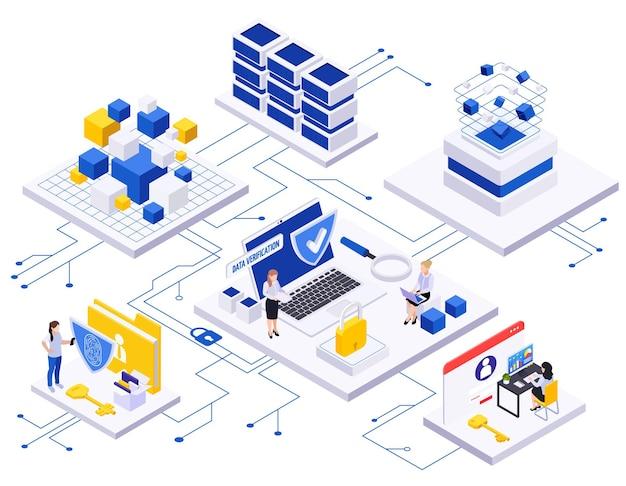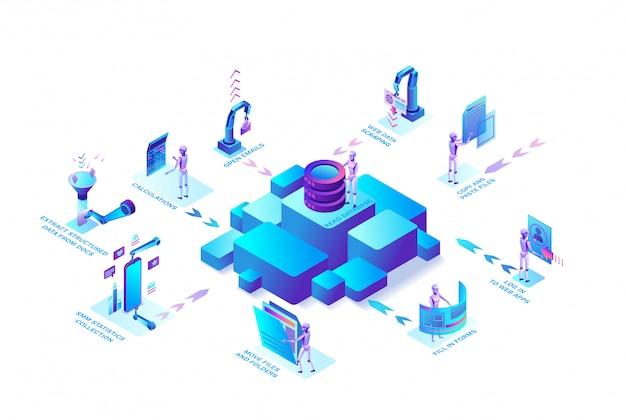Are you confused about the difference between RPA and ETL? Are you wondering which one is suitable for your business needs? If so, then this comprehensive blog post is just what you need! In this article, we will explain the differences between RPA and ETL, and which one is better for your business.
If you’re wondering whether RPA is outdated, then you’ll be surprised to know that it’s still very much in use. RPA has evolved over the years, and the new tools that have been introduced are more efficient than ever. Moreover, RPA tools comparison reveals that there are many different options available, each with its own set of features and benefits.
Did you know that there are three types of RPA? Yes, you read that right! The three types are Attended RPA, Unattended RPA, and Hybrid RPA. Each type has its own benefits, and we will discuss them in detail in this blog post.
If you’re wondering whether RPA or machine learning is better, then the answer is that it depends on your business needs. In some cases, machine learning might be a better option, while in others, RPA might be more suitable.
So, what is the difference between RPA and ETL? While both RPA and ETL are used for data integration, they have different approaches. RPA is used to automate repetitive tasks and processes, while ETL is used to extract, transform, and load data from one location to another.
Stay tuned for our next blog post, where we will dive into the specifics of RPA and ETL, and help you make an informed decision about which one to choose for your business.
RPA vs ETL: Differences and Similarities Explained
When it comes to automating business processes, the terms Robotics Process Automation (RPA) and Extract, Transform, Load (ETL) often come up in conversations. While they share some similarities, there are crucial differences between the two technologies that businesses should be aware of when deciding which one to implement.
What is RPA
RPA is the use of software robots to automate repetitive, rules-based tasks, such as data entry, file processing, and customer service. These robots mimic human actions to complete tasks, making them ideal for processes that are predictable and rule-based.
What is ETL
ETL is a process for extracting data from various sources, transforming it into a format suitable for analysis, and loading it into a data warehouse or data lakes for storage and retrieval. ETL is typically used for big data projects, where data comes from various sources and needs to be transformed and made accessible for analysis.
Differences between RPA and ETL
While both RPA and ETL involve automation, there are some key differences between them. One of the most significant differences is the scope of automation: RPA is focused on automating specific tasks, while ETL is focused on automating the entire data lifecycle.
Another difference is the level of technical expertise required. RPA can be implemented with minimal coding knowledge, making it accessible to non-technical users. ETL, on the other hand, requires specialized technical knowledge and expertise to set up and maintain.
Similarities between RPA and ETL
Despite their differences, RPA and ETL share some similarities. Both technologies are designed to streamline business processes and increase efficiency. They also both rely on automation to achieve their goals and can be used to reduce errors and free up employees for more critical tasks.
In conclusion, while RPA and ETL may seem similar at first glance, there are crucial differences between the two technologies. RPA is focused on automating tasks, while ETL focuses on automating the entire data lifecycle. Both technologies can improve efficiency and reduce errors, but they require different levels of technical expertise to implement and maintain. Businesses should carefully evaluate their needs to determine which technology is the best fit for their organization.
Is RPA Outdated
In recent years, Robotic Process Automation (RPA) has become ubiquitous in the business world. Many companies rely on RPA to automate repetitive tasks and improve efficiency. However, some argue that RPA is outdated technology and that businesses should be looking for newer solutions.
RPA Has Limitations
One of the criticisms of RPA is that it has limitations. RPA is designed to handle structured data, but it can struggle with unstructured data. Additionally, RPA is not equipped to handle tasks that require cognitive skills, such as decision-making and problem-solving. As a result, some argue that RPA is not a long-term solution.
RPA Is Evolving
While some argue that RPA is outdated, the technology is evolving. RPA providers are investing in new capabilities, such as natural language processing and machine learning. These advances are allowing RPA to handle more complex tasks and to work with unstructured data. As a result, RPA is becoming a more capable and versatile technology.
RPA Is Still Relevant
Despite its limitations, RPA is still a relevant technology in many industries. RPA can help businesses to improve efficiency and reduce costs. Additionally, RPA can free up employees to focus on higher-level tasks that require cognitive skills. While newer technologies may eventually replace RPA, it still has a place in the business world.
In conclusion, RPA is not outdated, but it does have limitations. While newer technologies may eventually replace RPA, it is still a relevant technology in many industries. As RPA continues to evolve, it will become even more capable and versatile.
RPA Tools Comparison
When it comes to choosing the right RPA tool, there are many factors that come into play. From ease of use to functionality to pricing, it can be overwhelming to decide which tool is the best fit for your specific needs. In this section, we’ll compare some of the top RPA tools on the market.
UiPath
UiPath is one of the most popular RPA tools, and for good reason. It offers a user-friendly interface, making it easy for even non-technical users to automate processes. UiPath also has a robust community with plenty of resources and support available. It’s compatible with a wide range of applications, making it a versatile option for any organization.
Automation Anywhere
Automation Anywhere is another top contender in the RPA market. It’s known for its advanced features, such as IQ Bot, which uses AI to improve automation capabilities. Automation Anywhere also has a strong security framework, making it a great option for organizations that prioritize data protection.
Blue Prism
Blue Prism is an enterprise-level RPA tool that’s highly scalable. It offers advanced analytics and reporting, making it easy to track the success of your automation efforts. Blue Prism is also highly configurable, allowing you to customize it to your specific processes and needs.
WorkFusion
WorkFusion is a cloud-based RPA tool that offers both RPA and AI capabilities. It’s known for its ease of use and quick deployment time. WorkFusion also offers a free trial, making it easy to test out before fully committing.
Kofax
Kofax is an RPA tool that’s designed for the financial industry. It offers advanced data capture and OCR capabilities, making it ideal for automating tasks like invoice processing. Kofax also offers strong compliance features, ensuring that your automation efforts meet regulatory requirements.
Overall, each RPA tool has its strengths and weaknesses, and it’s important to evaluate them based on your organizational needs. By considering factors like ease of use, functionality, and pricing, you can determine which tool is the best fit for your automation efforts.
What Are The Three Types of RPA
Robotic Process Automation (RPA) refers to the use of software tools or “bots” that can replicate human actions to complete repetitive tasks. RPA can be categorized into three types, which include: Attended RPA, Unattended RPA, and Hybrid RPA.
Attended RPA
Attended RPA is usedby human operators in a semi-automated environment. In this type of RPA, bots work alongside human workers, providing real-time processing assistance that complements the operator’s work. Attended RPA is ideal for applications like customer service or technical support, where RPA technology can reduce the workload of human employees.
Unattended RPA
Unattended RPA operates autonomously, without human input. In this type of RPA, bots are programmed to run according to a set schedule, activating when certain trigger events occur. Unattended RPA is ideal for applications like batch processing, data migration, and data entry.
Hybrid RPA
Hybrid RPA combines elements of attended and unattended RPA. In this type of RPA, botscan work independently or in conjunction with human operators. Here, bots can help to complete routine tasks autonomously while freeing up human workers to handle more complex work.
In conclusion, RPA technology can be employed in various forms, depending on the requirements of the business or organization. Understanding the three types of RPA can help businesses identify the best-suited application of RPA technology and get the most out of it.
RPA vs Machine Learning: Which is Better
When it comes to automation, two popular technologies worth comparing are robotic process automation (RPA) and machine learning (ML). Both technologies have received widespread adoption in recent years, offering businesses enormous potential for cost savings, improved efficiency, and better user experiences. In this section, we will evaluate the advantages and disadvantages of using RPA and ML to help answer the question, “Which is better?”
RPA: The Basics
RPA is essentially a form of software robot that mimics human actions to automate repetitive tasks. It involves creating a set of rules to automate an existing manual process, without requiring any changes to the underlying systems. RPA is best suited for tasks with clearly defined rules, such as data entry, report generation, and order processing.
Machine Learning: The Basics
Machine learning, on the other hand, is a type of artificial intelligence (AI) that provides computers with the ability to learn from data, without being explicitly programmed. It uses algorithms to identify patterns in data and automatically improve its performance over time. Machine learning is best suited for tasks that are data-driven and require complex decision-making, such as fraud detection, customer segmentation, and predictive maintenance.
Comparing RPA and Machine Learning
While both RPA and machine learning offer unique benefits, they have some distinct differences that make them suitable for different use cases. Here are some key areas where they differ:
-
Flexibility: RPA is less flexible than machine learning. It operates based on predefined rules, and any changes to the process require manual intervention. Machine learning, on the other hand, can adapt to new data and learn as it works, making it more flexible over time.
-
Complexity: Machine learning is more complex than RPA. It requires a high level of technical expertise and a significant amount of data to train the models. RPA, on the other hand, is relatively simple and can be set up quickly without any coding.
-
Accuracy: RPA is extremely accurate, as it follows a set of predefined rules. Machine learning, on the other hand, can be less accurate if the data used to train the models is incomplete or biased.
-
Application: RPA is best suited for repetitive tasks with clear rules, while machine learning is best suited for complex tasks that require decision-making based on patterns in data.
Which Should You Choose
So, which is better, RPA or machine learning? The truth is, it depends on your specific business needs. If you need to automate repetitive, rule-based tasks quickly, RPA is the way to go. However, if you want to leverage data to gain insights and make complex decisions, machine learning is the better choice.
In the end, the decision comes down to the specific use case, the complexity of the task, and the available resources. Whatever you choose, both RPA and machine learning offer tremendous potential for businesses to reduce costs, improve efficiency, and enhance the user experience.
What is the Difference Between RPA and ETL
If you’ve been keeping up with the latest technological trends, you might have come across the terms RPA and ETL. While they might sound like confusing buzzwords, they’re actually quite simple concepts to understand. In this section, we’ll explore what each term means and how they differ from each other.
Understanding ETL
ETL stands for Extract, Transform, Load. It’s a process that’s used to move data from one place to another. First, the data is extracted from the source system, then it’s transformed into a format that’s suitable for the target system, and finally, it’s loaded into the target system. This process is crucial for keeping data consistent across multiple systems.
RPA at a Glance
RPA stands for Robotic Process Automation. It’s a technology that uses software robots to automate repetitive tasks. These robots are programmed to perform a sequence of tasks, just like humans do, but with greater accuracy and speed. The ultimate goal of RPA is to increase efficiency and reduce errors in business processes.
Differences Between RPA and ETL
While both RPA and ETL deal with data, they are used for different purposes. ETL is mainly used to move data from one system to another, while RPA is used to automate repetitive tasks. ETL deals with structured data, which is data that fits into predefined formats. In contrast, RPA can handle both structured and unstructured data, making it a more versatile tool.
Another major difference between the two technologies is the level of human involvement. ETL requires manual intervention, as data analysts are needed to design and implement the transformation processes. On the other hand, RPA is fully automated, with no human involvement required.
Wrapping Up
In conclusion, both RPA and ETL are important technologies used in different contexts. ETL is mostly used to move data between systems, while RPA is used for process automation. However, they both play vital roles in improving the efficiency of business processes. By understanding the differences between the two, you’ll be better equipped to decide which technology is best suited for your specific needs.



